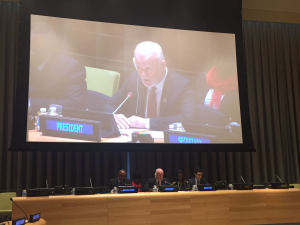As delivered
Closing Remarks of H.E. Peter Thomson, President of the 71st Session of the UN General Assembly, at High Level Dialogue on Building Sustainable Peace for All: Synergies between the 2030 Agenda for Sustainable Development and Sustaining Peace
25 January
 Honorable Ministers and High-level Dignitaries,
Honorable Ministers and High-level Dignitaries,
Excellencies,
Ladies & gentlemen
I would like to thank you for your active participation in this High Level Dialogue on Building Sustainable Peace for All.
Throughout it all, I have been struck by the quality of the discussion that has taken place, and the high-level of interest from Member States and other partners in taking forward sustainable peace and development – as evidenced by our need to extend the plenary debate into today.
Excellencies,
Throughout the opening segment, high-level session, plenary debate, interactive panel discussion, and the three workshops, speaker after speaker rose to emphasise the fundamental reality that there can be no sustainable development without sustaining peace, and that there can be no sustainable peace without sustainable development. We may take it that henceforth this is an established tenet of the United Nations.
Yesterday, we began with the benefit of hearing from the experiences of Colombia, the Democratic Republic of the Congo, Sierra Leone, Timor-Leste and other countries that have experienced the horrors of war, the struggle for peace, and the disastrous impacts that conflict inflicts on sustainable development.
We also brought together – for the first time – leaders from across the United Nations General Assembly, Security Council, and Economic and Social Council, as well as the Chair of the Peacebuilding Commission, and the United Nations Secretary-General, to hear their perspectives on ways the United Nations can promote coordination and coherence across its activities to build sustainable peace and development.
Secretary-General Guterres summed up these views when he said “We need a global response that addresses the root causes of conflict, and integrates peace, sustainable development and human rights in a holistic way”.
The Secretary-General also laid out his roadmap for reforming the United Nations to ensure that it is able to do more to prevent conflict and sustain peace. He stressed his commitment to advancing a surge in diplomacy for peace, and to establishing a platform that will help integrate the prevention capacities of the UN system, following work by his Special Advisor on Policy.
The Secretary-General pointed to the reform of the UN Development system, on which he will report in June, and noted the importance of ensuring that the development system better serves the needs of Member States, and operates coherently to better deliver results. He also highlighted the need to overhaul UN administrative rules and regulations that discourage integration.
Throughout the day and half of discussions, a number of key themes, areas of convergence, and ideas to leverage the mutually-reinforcing nature of the sustaining peace and sustainable development agendas, emerged.
Speaker after speaker emphasized the importance of conflict prevention to creating an enabling environment for sustainable development to thrive, and that the best means of preventing conflict and sustaining peace is addressing root causes and pursing inclusive and sustainable development.
They drove home the importance of inclusivity to these efforts, of building social cohesion – including through inter-faith dialogue, of ensuring that the vital contributions of women and youth are captured in peace and development process, and of ensuring that no one is left behind in the implementation of the Sustainable Development Goals.
A particular emphasis was placed on the importance of ensuring equitable access to education, opportunity, and employment, particularly for young people.
The dialogue underlined the need for human rights protections, for justice and rule of law, and for effective and accountable institutions to sustainable peace and development – not only to achieve SDG16, but as a golden thread running through the implementation of all 17 Sustainable Development Goals.
The dialogue also highlighted the universal applicability of both the concept of sustaining peace and the Sustainable Development Goals, as well as the critical importance of promoting unity of action and coherent approaches to their implementation.
This includes by pursuing strategic partnerships that bring together key actors from across Government, the UN system, regional organisations, civil society, international financial institutions, and the private sector, so that their work is coordinated, complementary and mutually-reinforcing.
And it includes advancing urgent reforms within the United Nations system to break down siloes, to address fragmentation of work between UN Headquarters and the field, to strengthen accountability for delivering results, and to increase coordination and coherence so that all development, humanitarian, human rights, and peace and security actors work towards the same goal of sustainable peace and development.
Critically, speakers also highlighted the important role of Member States in supporting these efforts – through national ownership of peace and development processes, and through lending their political support to UN reform efforts so that the system has the tools it needs. Emphasis was also placed on providing adequate and sustainable financing to peace and development efforts.
Many of these headline issues were addressed in greater detail during the three workshops that followed, and which featured participation from Member States, civil society and the private sector.
In the first workshop on ‘Empowering women and youth’, participants underlined the importance of women and youth as drivers of sustainable peace and development, and of the need for them to be placed at the centre of inclusive peace and development efforts. The workshops stressed that specific policies and mechanisms were needed to change the narrative of women and youth being victims in need of protection, or constituencies in need of serving, to one of promoting understanding their role as critical participants in peace and development efforts.
The workshops shared experiences, and reflected on challenges faced by women and youth seeking to participate in peace and development processes in Sri Lanka, Libya, Nepal, Liberia and South Africa. They pointed to a number of well-known examples of the important contribution young women activists can make to peace and development, and of the deep-seeded barriers they can face to participating in public life.
Many speakers regarded Security Council resolutions 1325 on Women, Peace and Security, and 2250 on Youth, Peace and Security as having raised global awareness of their importance to peace and security efforts, but stressed that greater education, opportunity, and resourcing was needed to continue amplifying and multiplying the role and leadership of women and youth in peace and development processes.
The second workshop on ‘Managing Natural Resources’ saw participants highlight examples of country situations where poor management of natural resources has contributed to the outbreak of conflict, including in Colombia where 58 percent of de-forestation has occurred in conflict affected areas, and Niger where two conflicts over the last 30 years can be traced back to the impact of droughts.
Participants also noted the growing impacts of climate change around the world, and the risk they pose to exacerbating existing tensions over resource scarcity.
At the same time, examples were also shared of action taken in Timor Leste, Kenya, Egypt, Honduras, Tajikistan, Hungary, Botswana and beyond, to manage land, water and extractive resources in a way that reduces the risk of conflict and increases the prospects of sustainable development.
The need for long-term planning, ecosystems valuation, equitably sharing the benefits of resource use, and ensuring environmental sustainability throughout the resource-management cycle, were emphasised. The need for resources to be managed by transparent, effective, and ideally decentralized governance systems that can monitor resource change, and empower local communities, was also stressed. Particular emphasis was made on the need for solutions to be implemented at scale and at speed, in order to preserve the ecosystems on which our prosperity and well-being depend, and to ensure that natural resources lead to an expansion of peace across the world.
In the third workshop on ‘Strengthening transparent, inclusive and accountable institutions’ participants underlined the importance of such institutions to building peaceful, inclusive and sustainable societies.
With social, economic and political exclusion being a major cause of conflict, building inclusive political institutions and participatory decision-making processes was essential to creating the conditions needed for long-term peace, and achieving the Sustainable Development Goals.
Workshop participants highlighted the importance of building trust between the State and its citizens to achieving sustainable peace and development. Introducing mechanisms to objectively measure SDG implementation progress was identified as essential in this regard. So too was building multi-stakeholder approaches to peace and development, which bring together Government representatives, civil society, the private sector, and local communities – including women, minorities groups, and youth.
In addition to discussing the challenges involved, participants also shared lessons learned from national efforts towards strengthening accountable, transparent and inclusive governance, including through the creation of a Commission Against Impunity in Guatemala, the enshrining of transparency, accountability and inclusiveness provisions in the Constitution in Tunisia, and the codification of the role of the Public Protector, and the Gender Equality Commission, in the Constitution in South Africa, thereby safeguarding these institutions, and strengthening democracy.
Excellencies,
As we look to conclude this rich and fulsome Dialogue, it is vital that we ensure that the ideas that have been discussed over the last day and a half do not end here, but that they become a foundation to take forward implementation of both of these critical agendas.
This first requires that we take the conversation on sustaining peace and sustainable development outside of the halls of the United Nations, in order to increase awareness, understanding and ownership of the concepts by all stakeholders, and so that it can be used as an entry point for dialogue between Governments and their citizens, thereby enhancing mutual trust and coherence in peace and development processes.
The second requires action and reform by the UN System under the leadership of Secretary-General Guterres and with the active support and engagement of member states.
As President of the General Assembly I am committed to doing all I can to support these efforts.
This includes by preparing a summary of this High-Level Dialogue, which will be circulated to all Member States and placed on my website in coming days, and which will contribute to preparations for the High-Level meeting on “Peacebuilding and Sustaining Peace”, to be convened during the 72nd session of the General Assembly.
I will also be continuing to engage closely with the Presidents of the Security Council and ECOSOC, the Secretary-General, and the new Chair of the Peacebuilding Commission on ways to improve coherence and coordination of our peace, development and human rights, efforts.
And I will continue to look for opportunities to raise awareness of the need for stakeholders to build on the synergies in the 2030 Agenda and the sustaining peace resolutions, and to translate these commitments from words into action – including by the United Nations.
Lastly, allow me to thank all those who worked to make this event possible – to Ambassadors Kamau and Skoog and the Peacebuilding Support Office for their initiative; to our workshop partners UN Women, the World Resources Institute, and the International Peace Institute; to staff in my own office and across the Secretariat who ensured everything ran smoothly; and lastly to Member States for contributing so actively throughout.
Thank you.

